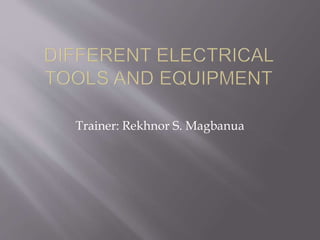
common 2.pptx
- 1. Trainer: Rekhnor S. Magbanua
- 2. There are different types of tools and equipment used in electrical installation and maintenance. All of them serve different purposes and knowing about them and how to operate them helps you become more efficient in your job. As an electrician, you must also know how to care for these tools and equipment to prevent accidents from happening.
- 19. Electricians use different types of equipment to measure the various components of electricity. Here is a list of commonly used electrical testing equipment:
- 26. Analog multimeters are inexpensive electrical testing instruments that measure voltage, current, and resistance. It is preferred by some electricians because the continuous movement of the needle allows more precise monitoring of changes in current and resistance that the digital multimeters cannot make. Analog multimeters cost less than digital multimeters.
- 28. The display features the scale, the needle or pointer, and the dial or infinity knob. The scale shows the value of what is being measured. There are usually three arcs printed behind the needle, which represent three different scales: The Ω scale is for reading resistance. This is usually the largest scale and is located at the top. It differs from the other scales because the 0 (zero) value is on the far right instead of the left. The "DC" scale is for reading DC voltage. The "AC" scale is for reading AC voltage.
- 29. The needle, also known as the pointer, indicates the values read from the scale. The dial or infinity knob points the needle to the 0 at the left side of the scale. The zero ohm adjuster is for the manual adjustment of the needle to the right side of the scale. The range shows more accurate measurements for small values. The range selector knob enables the changing of function and scale. The two test probes are used to connect to the circuit or device under test. The positive probe is red and the negative probe is black.
- 30. Digital multimeters are used to measure voltage, current, resistance. It can also be used to check the continuity of wires and fuses. Unlike the analog multimeter, digital multimeters show more precise reading through digits on an LED or LCD screen. Hence, it can read the decimal places of the measurement, whereas in the analog multimeters, you can only get the approximate value.
- 32. Display - where the measurements can be read Rotary Range Selector Dial - enables you to choose the function that will be used on the meter Connection Sockets - where the 4mm probe leads are plugged. Test Probes - used to connect to the circuit or device under test.
- 33. A clamp-on tester or clamp meter is a type of electrical tester that has the function of a basic digital multimeter with a current sensor. The clamps measure the current, while the probes measure the voltage. The hinged “clamp” jaw allows for easier current testing by clamping around the conductors at any point in the electrical system without having to disconnect the conductors.
- 35. Clamps - used to hold the conductor to detect and measure current Clamp-opening Trigger - opens the clamps when pushed Display - shows the reading of the measurement Dial - allows the changing of quantity and resolution Alignment Marks - indicate where the conductors must be placed Test Probes - connect to the circuit or device under test
- 36. Maintenance is defined as keeping a tool, equipment, room, or organization functioning and preserving them from failure or decline.